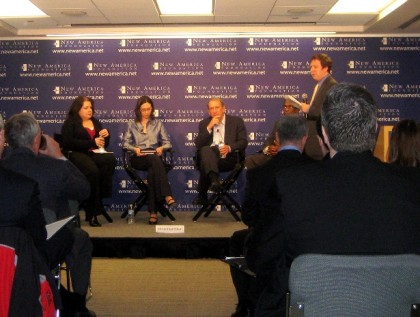Everybody agrees. Let’s have bigger broadband and more of it. But who pays for greater access, how networks will get updated, and what aspects of the industry should be regulated are much gnarlier questions. These were some of the central points of debate in a New America Foundation event yesterday featuring Blair Levin, former FCC commissioner and project lead on the national broadband plan, and industry analyst Craig Settles.
The panel discussion was a lively one, moderated by GigaOM‘s Stacey Higginbotham and The Wall Street Journal‘s Amy Schatz, and it led me to several new thoughts on government broadband strategy. First, I gained new appreciation for the care and consideration that went into crafting the broadband plan. There are a lot of trade-offs that have to be made, and – whether or not you agree with the results – the options appear to have been examined carefully as the plan was drafted. As one example, the plan aims for speeds of 4 Mbps downstream and 1 Mbps upstream everywhere. Beyond financial and application considerations (which are significant), part of the rationale for this is because it makes mobile broadband a viable service competitor in rural areas. The more providers you have, the more downward pressure there is on prices.
